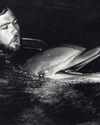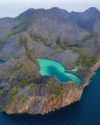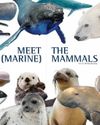Tek diving gives us access to rare and remote places, places not only inhabited by majestic hammerhead sharks, but that could also yield vital scientific data.

Ever since I was a child, I have been interested in marine life, so I started to wonder about the reasons why sometimes the sharks could be found at Rasdhoo Madivaru, and sometimes they could not. I spent long periods of time in the area, diving to see these sharks. I dived the site many times, observing Nature, and comparing the conditions on each different dive. One thing I noticed was consistent in the shark sightings was the temperature; whenever I hit the thermocline, with temperatures between 28 degrees and 25 degrees Celsius, I saw several hammerheads, no matter the depth – from as little as 15 down to 40 metres.
I suggested my theory of seeing the hammerhead sharks whenever I hit the cold thermoclines to the scientists working for IUCN Maldives and they said that it might just be right. Since I am a tek diver, capable of doing deep dives, I suggested that I could place some temperature loggers (see box) in the Madivaru Channel. We placed five loggers from five metres to a depth of 60 metres.
Bu hikaye Asian Diver dergisinin Issue 04 - 2016 sayısından alınmıştır.
Start your 7-day Magzter GOLD free trial to access thousands of curated premium stories, and 9,000+ magazines and newspapers.
Already a subscriber ? Giriş Yap
Bu hikaye Asian Diver dergisinin Issue 04 - 2016 sayısından alınmıştır.
Start your 7-day Magzter GOLD free trial to access thousands of curated premium stories, and 9,000+ magazines and newspapers.
Already a subscriber? Giriş Yap

The Sea Specialist: An Interview With Bret Gilliam
Most people learn to crawl before they walk, but there is a man who learned to swim before taking his first steps. Diver, entrepreneur, writer, athlete, maritime specialist – Bret Gilliam is the complete package. Just add water.

The Best Of Diving In Southeast Asia: Explore The Amazon Of The Seas
Southeast Asia encompasses the world’s most biodiverse reefs and some of the best diving anywhere on the planet. From the tiniest and rarest critters to huge fish schools and the biggest pelagics, the region has it all, and there’s something to suit divers of any level.

Below With David Doubilet & Jennifer Hayes
Best known for their work with National Geographic, David Doubilet and Jennifer Hayes came together to discuss their work with the youth, and, as Jennifer put it, “submerging with the emerging talent”.

Underwater Images For The Giant Screen
Howard and Michele Hall are best known for their success in underwater IMAX filmmaking.

Journey To Filming For National Geographic Wild Brazil
Cristian is an acclaimed and highly versatile Brazilian wildlife filmmaker who works both underwater and topside.

Breaking The Barrier: The World's Deepest Dive
David Strike shared a brilliant presentation about the history of deep diving and how Lt. George Wookey achieved the world’s deepest dive in 1956 using a surface-supplied rebreather.

Dive the Golden Land
The Best of Diving In Southeast Asia

OFFICIAL LAUNCH OF BLUE HOPE
Top Session of the Week (14,319 (Views) / 42,831 (Reach)

MEET THE (MARINE) MAMMALS
MEET THE (MARINE) MAMMALS

Fashion Faux Pas
What can be done to mitigate the impact of the garment industry on our oceans?